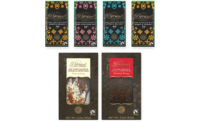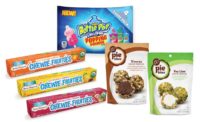Dan Abel Jr., v.p. of operations for Chocolate Chocolate Chocolate Co., was apprehensive about entering the chocolate bar market in late 2016.
There was already a dizzying array of options on grocery and convenience store shelves, and the St. Louis-based company had a legacy of selling artisan truffles, barks and caramels in its half-dozen retail stores.
But, as it turns out, Abel had nothing to fear.
Since its launch almost three years ago, Chocolate Chocolate Chocolate’s line of 3.5-oz. bars has become the company’s largest revenue source, requiring investment in new packaging and manufacturing equipment just to keep up.
“Our biggest concern getting into the chocolate bar category was that it was a crowded field,” Abel said. “Although it does take a few steps to get onto the shelf, I feel like instead of being competitive with the other chocolate companies out there, you want to work in harmony together. When I’m paired next to other premium companies’ products, it elevates the brand Chocolate Chocolate Chocolate.”
While the amount of options may be daunting, it works in the consumer’s favor, Abel noted, since it pushes chocolate bar manufacturers to find their niche through choice of ingredients, flavor combinations, packaging and price.
“Some people want you to taste the pure chocolate,” Abel said. “Some people like to bring flavors and spices together. Some people like to have the very traditional solid milk. There are a few us going into fun, creative flavors, and those are the ones that, to me as a consumer, excite me the most. That’s how I wanted to design our line.”
After narrowing it down from 30 concepts, the Abel family started with a handful of core bar flavors, including among them Milk Chocolate Peanut Butter Banana, Milk Chocolate Waffle Cone Caramel and Dark Chocolate Bee-Berry Honey Caramel.
The company’s most recent launches have been even more whimsical, including the Milk Happy Birthday Truffle Bar, featuring buttercream frosting truffle and sprinkles, and the Milk Chocolate Cannoli Truffle Bar, which includes a custard truffle filling, cannoli shell pieces and chocolate chips.
Whatever the flavor, Chocolate Chocolate Chocolate uses bright colors and eye-catching photography of the bar’s ingredients to stand out on store shelves.
Pointing to the waffle cone and the flowing caramel on the packaging for the Waffle Cone Caramel bar, Abel said customers get a clear idea of what’s inside.
“If that doesn’t tell you what you’re buying, I don’t know how else we can do it,” he said. “The photo really tells a story.”
Abel also said price point is key, noting that $4.99 is the threshold at which consumers will make an impulse purchase or risk trying a new product. Andy Schuman, president and ceo of Colorado-based Hammond’s Candies, agreed.
“When you start getting over the $5 range, it becomes a conscious decision,” Schuman said. “If it’s under that range, people may not think about it as much because the cost is somewhat equal to permissibility.”
But that doesn’t mean the quality isn’t there. Schuman said the chocolate bar category has reached new levels over the last decade, thanks to unique, high-end ingredients.
“The chocolate bar as we know it has gotten very gourmet, especially in the specialty food industry,” he said. “It’s been a great thing for the industry.”
Hammond’s Candies develops chocolate bars inspired by long-loved flavor combinations that aren’t typically seen in chocolate. Schuman said the company introduced its PB&J Sandwich bar eight years ago, one of the first on the market. Recent launches have included Soda Pop!, featuring cola-flavored milk chocolate with popping candy, and Coconut Cream Pie, with milk chocolate, creamy ganache and shredded coconut.
Hammond’s best seller, the Pigs N’ Taters bar, includes potato chips and bacon pieces in milk chocolate. Schuman said that bar has developed a cult following.
“We feel like we’re playing in the chocolate bar space, we’re just trying to do it a little bit different,” he said.
It also helps to play off of existing strengths. Hammond’s produces inclusions for some of its chocolate bars, such as bits of peppermint, toffee and brittle. Schuman also pointed to a recent launch from Mars Wrigley Confectionery — a line of milk chocolate tablet bars with M&M’S Minis and other crispy, crunchy ingredients.
“That was pretty neat and innovative,” he said. “It’s taking something they already do and making it into something that’s unique and better.”
The M&M’S chocolate bars, ranging from 3.8 oz. to 4 oz., hit the market in December 2018. The line features Peanut, Milk Chocolate, Crispy, Almond and Crispy Mint.
“The industry is changing and consumer tastes are evolving,” said Allison Miazga-Bedrick, senior brand director, M&M’S brand, in a December news release. “We’re continuing to recognize and anticipate demand. We’re excited to debut M&M’S Chocolate Bars and know that our M&M’S fans and chocolate bar lovers alike will appreciate the delicious taste that comes from our rich and creamy chocolate.”
Whether it’s incorporating well-known inclusions in an unconventional way, or pushing the limits of creativity with flavor, it is possible for chocolate bar brands to carve out space for themselves, Abel said.
“There’s no limit to the chocolate world,” he said. “It’s an amazing industry.”










